

New Hampshire Times - January 19, 1977 - Page 13
(Part 2)
ROOTS:
unlocking the secrets of the White Goddess and the Cretan maze
Last week Bart Jordan's decipherment of the meander, one of the oldest symbols of humanity, was published for the first time. In the academic world, the work could gain international recognition. In the social world, it could adjust our thinking about peoples of the upper paleolithic period as being capable of far greater intellectual powers than we presently know or admit. In addition, it could help us to identify more closely with our ultimate ancestors.
The process of cultural deciphering demands creative imagination, undiluted logic, and unyielding per- severance. Likewise, the process of following Jordan's work requires an investment of time and focus. The dividend, however, reaps a sense of inevitability that, yes, this is the way that the ancients constructed and interpreted their timeless symbols.
Jordan carries with him the tools he prizes and uses--among them "The Greek Myths" and "The White Goddess" by Robert Graves and "The Gods and Goddesses of Old Europe 7000-3500 B.C." by Marija Gimbutas.
Most of all he carries seven years of thinking about the methods of symbol construction by paleolithic peoples. One of the most startling discoveries he made was confirmed unexpectedly by the ancient Lespugue statuette of white ivory found in southern France. Jordan had constructed a series of notations that eventually led to the White Goddess symbol overlapping nearly exactly with this Great Mother statuette fashioned in paleolithic times.
How he deduced the symbol was, he maintains, the same method by which the paleolithic artists derived their shaping of the Great Mother figure. The steps are many, but the basic ones follow.
Jordan began with the 13-halls lunar-solar grid ex- plained in last week's article. Also explained was the pubic triangle, which was shown to signify the lunar- menstrual month of 28 nights. What was true of the pubic triangle is also true of the bison horn held by the so-called "Venus" of Laussel. The semi-circular bison horn, appearing something like a crescent moon, follows the numbers 3 4 8 7 6 (adding to 28) and goes east to west, thereby outlining the moon's apparent journey through the heavens. On the horn held in the right hand of the Laussel figure are etched 13 lines indicating the total number of 28-night cycles in a lunar-menstrual year of 364 nights.
The relationship of the symbols can be seen in this way:

The bottom numbers of the octagonal form add to 28, another reference to the menstrual cycle. Jordan took the bottom five sides of the octagon and saw that it was the same as the five-sided box notation still used with its ancient Chinese note-names by modern Japanese musicians. The third note chio assigned to the middle finger (position of number 8 on the octagon), in fact, means horn. "A very interesting point," he said.
The separate line-segments of the five-sided box unit give the concept of the outstretched left hand--palm up--with two vertical lines (thumb and small finger), one horizontal line (middle finger), and two oblique lines (index and ring fingers).
"You take that same unit," he said, "and say, now I'm faced with the problem of making seven different signs or characters out of a unit that would normally make only five."
To make a notation for a seven-night week, he first uses the plain five-sided box symbol as the head- character (signifying moon-day or monday) and differentiates the other six nights by hooked lines on the outside of the pentagonal portion of the octagon. He adds a paramiddle line (next to the middle finger) for the day corresponding to friday. These six actually correlate with the first six letters of the old Greek alphabet--alpha, beta, gamma, digamma ("The only case where you have a di-anything in Greek letters."), delta epsilon. Below is east week with its appropriate directional sign set in all seven characters; the remaining three weeks (south, west, and north) would likewise be distinguished by their respective directional signs:
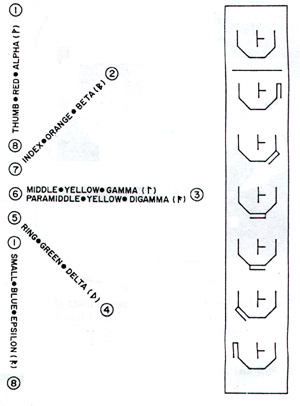
"What you have here are seven separate signs or characters expressing the seven-night week that are thoroughly clear and totally symmetrical," Jordan said. "Beyond the head-character, one is opposite six, two is opposite five, and three is opposite four. All add up to sevens, the same way most ancient cubical dice did for blind musicians learning the six-semitone units of the tetrachord system.
Next he took the oldest folk-sign for month--a box with two diagonal lines crossed. Broken down, this symbol has two verticals, two horizontals, and two obliques, the same configuration of lines as the left hand (with the para-middle or digamma insertion) that he deduced the ancients themselves used as the basis for various notations:
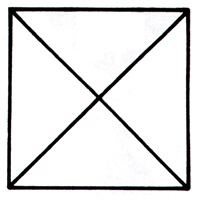
He then formed with those same number of lines a box-like figure quartered into weeks. From the resulting Four Quadrants notation, he built the Arrowchain notation to represent the seven nights of each week. (The lines with the arrowheads correspond to the spread fingers of the left hand plus its para-middle line.)
The evolution of the notation is:
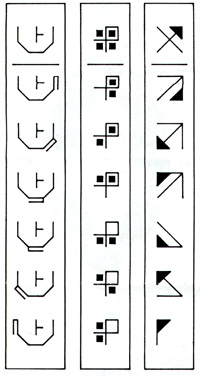
The initial week of all three lunar-menstrual notations follows the apparent progress of the moon from rising to setting. "That's why even though these notations are not extant, I know what they had to have looked like," he said. "They, like the moon, go from east to west. That's the path I had to take. Actually, anyone attempting to reconstruct the notations would be forced to follow the selfsame path by virtue of what has to be communicated by those notations."
Jordan arranged the complete Arrowchain menstrual notation of four sennights or seven nights around a red circle symbolizing menstruation. The four sennights were positioned in accord with the directions of east (traditional rising point), south, west, and north. The Arrowchain notation can be seen to turn four times; the word week itself means a turning:
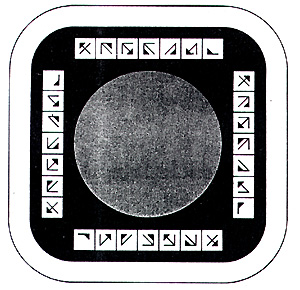
From the four sennights square, he paired the four weeks into two fortnights or 14 nights set between the split red circle. (In England, to this day, the "common law" month, be it reckoned as four sennights or two fortnights, is still regarded as 28 nights. Again, it reflects the ancient calendar of 13 menstrual cycles for the 364-night year.)
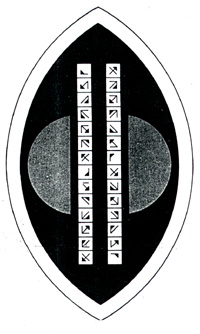
The notation is his deduction, but the oblong figure enclosing it is in the shape of a mandorla, symbol for the Great Mother or White Goddess, recognized the world over. One side or the other of the two fortnights symbol is often found among paleolithic graffiti and is clearly associated with the female. "It very much relates to the Shang Chinese character meaning egg or female ovaries," he said. "The paleolithic symbol shown here indicates only one fortnight, whereas the Shang character indicates the two fortnights further subdivided into four sennights via the center split-lines."
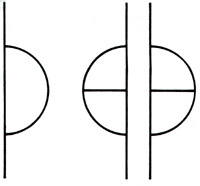
Next Jordan constructed both the swastika-like diagram housing the Arrowchain notation and its graphic complement, the derived rosette. (Directly related versions of the diagram and rosette have been found among the ancient Maya ruins in Guatamala and Mexico.)
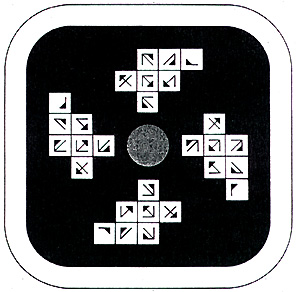
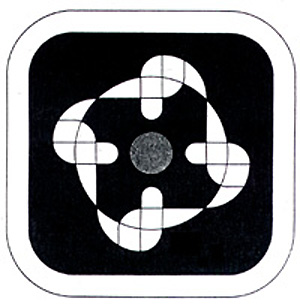
He then constructed a two fortnights version of the rosette and found that this symbol depicted the shape of frogs back to back "Frogs or toads among any number of peoples," he said, referring to Egyptians, Mayans, Northwest Coast Indians, and others, "are considered to be related to a birth goddess, if not the lunar-female or White Goddess herself."
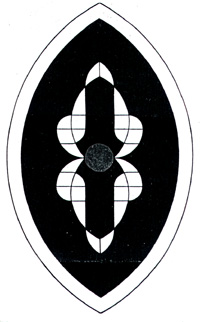
From the back-to-back frogs symbol, Jordan evolved the White Goddess image. "You can actually trace the whole gamut of these particular symbols and their specific construction right back to the formation of the Arrowchain menstrual notation," he said.
Five years ago he was giving a lecture in Professor John Hatch's history of art class at the University of New Hampshire. "During the course of it, I had the schematic of the White Goddess on the screen," Jordan said. "Professor Hatch said, `Are you aware of the Lespugue statuette? I think you ought to know that the Lespugue is almost a perfect match for what you have there.'
"So quite excitedly we went back to his house and looked at his copy of Bandi's "Art in the Ice Age" which has front, back, and side views of the Lespugue. I think we both kind of flipped because the Lespugue was virtually a dead-on match for the White Goddess." Jordan had seen the similar Willendorf statuette but not the Lespugue. Here is the comparison of Jordan's White Goddess with the Lespugue that warmed his and Professor Hatch's hearts on that cold March day five years ago:
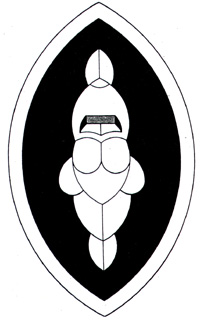
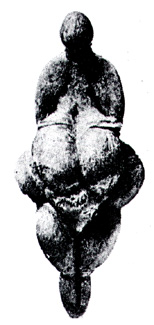
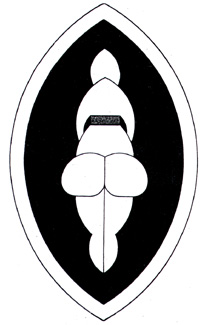
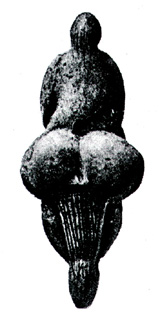
Statuettes such as the Lespugue were fertility figures in the ancient world. Jordan feels that an extraordinarily high level of scientific thinking and logical consistency went into the production of them and the lunar-menstrual tradition as a whole. The statuettes represent an intellectual and artistic culture that demands much more respect than modern man renders to early peoples.
Jordan's deciphering of a somewhat later symbol from an entirely different tradition also has meaning for us. According to his analysis, pub- lished here for the first time, the so-called Cretan labyrinth or maze is based upon an abbreviated direction/season count.
Again, he began with the lunar-solar grid of 13 halls which the ancients used as their main symbol of the year. "They started abbreviating," Jordan said, "because someone realized that multiplying 3 times 4 times 5 times 6 resulted in 360, the base year or annual circle. So the clever devils turned around and said they would draw a circle, retain 3 for east/spring, 6 for west/autumn, and use 4 for south/summer, 5 for north/winter."

"This abbreviated set of year-numbers and the accompanying swastika became very important," he said, "because early peoples used it in a thousand different ways."
The labyrinth or maze was one of the ways in which the early peoples chose to use and preserve the abbreviated set of year-numbers. The labyrinth is inscribed on tablet from Pylos, Crete, and is also engraved on coins from another part of the island, Knossos. The tablet dates from the 13th century B.C. and the coins from the 5th century B.C. It has also been found in the British Isles, Spain, Scandinavia, North America (in a pre-Columbian context), and other places throughout the world.
Traditional stories centered about the maze include that of Troy and that of Crete. "All over Europe," Jordan said, "the mazes are referred to in many languages as Troy towns or the walls of Troy. They really expressed the year and were connected with the horse for that reason. The horse was considered the year-bearer because of its 36 ribs. Likewise, the maze has a specific line-count or wall-count of 36; both the horse and the maze symbolize the base year as 360.
How were the walls of Troy breached? "By the famed wooden horse," Jordan said. "According to legend, the man who built the western curtain of the walls was Aeacus. It was said that Troy would be breached from that side, the weakest portion of the wall. The Trojans knocked down their own wall on the ill-fated western side to admit the huge wooden horse which the Greeks had left on the beach, knowing that it would not fit through the city gates. You will remember that the Greeks had for the moment sailed out of sight, leaving enough men inside the belly of the wooden horse to dispatch the guards of the gates and towers while the Trojans were reveling, unaware that the Greeks had only feigned retreat."
The Greek word for Troy was truia, which is also the word for labyrinth or maze. The other principal story connected with Jordan's symbol was that of the labyrinth built by Daedalus for King Minos of Knossos, Crete. "The labyrinth contained the Minotaur, a bull-headed creature," Jordan said. "He was the one who devoured the seven maidens and seven youths that were sent in tribute from the city of Athens to the Cretan king Minos. Theseus, deliverer of the Athenians, thought the tribute cruel and volunteered to kill the Minotaur with his bare hands, or as some say, with a short sword. Ariadne, Minos' beautiful daughter, fell in love with Theseus and gave to him a magic ball of thread that unwound through all the passages. Theseus went from outside the labyrinth to its core, the sacred sanctuary, where he killed the bull-headed creature. He then turned about and followed the thread, rewinding as he wended his way out of the labyrinth."
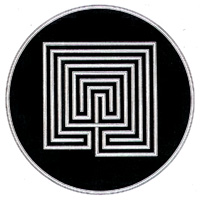
One of Jordan's major decipherments was the abbreviated direction/season scheme referred to earlier. As a result, he knew what to look for in deciphering the maze.
The maze is always constructed by starting at the upper right wall-end, which is located in the northeast quadrant formed by the crossed walls of the completed maze. The wall can be seen to move upward and counter-clockwise for 3 segments, then clockwise for 9, and back counterclockwise for 6 (terminating in the southwest quadrant). The total of the numbers is 18, standing for 180, with the year-numbers of 3 east/spring and 6 west/autumn being offset. Construction of the maze is continued by turning now to the upper left wall-end which is located in the northwest quadrant. This wall can be seen to move upward and clockwise for 5 segments, then counterclockwise for 9, and back clockwise for 4 (terminating in the southeast quadrant). The total of the numbers is 18, standing for 180, with the year-numbers of 5 north/winter and 4 south/summer being offset. Given the completed maze with its 36 walls standing for 360 as the base year and the offsetting of the year-numbers of 3 6 5 4 which multiply out to 360, there can be no doubt of the maze being a year symbol.
But is the maze only a year symbol or does it have yet another meaning within its magical walls? Jordan says it does. He considers the upper pyramidal side of corridors as being numbered 8 to 2, 1 being the sanctuary at the core. If the path through the maze is begun at the opening on the bottom side, the first corridors passed through are 6 and 7. Then corridors 8 and 5 and 2 follow. Finally, corridors 3 and 4 are passed through in coming to the sanctuary where Theseus encountered and killed the Minotaur.
"We have a very deceptive piece of work here," he said. "The maze contains within its ordering of the passages a formula for the planet Venus."
He explained that the three middle corridors passed through in sequence are 8 5 2. These multiplied equal 80. Multiplying the numbers of those corridors which embrace the middle corridors in their order of passing, numbers 6 7 3 4, equals 504. The sum of 80 and 504 is 584, here again referring to the average synodical revolution of the planet Venus.
"This decipherment is further substantiated," Jordan said, "in that Ariadne (meaning "the very holy one") is thought by some to be an earthly personification of Aphrodite, the goddess of love. The Roman name for Aphrodite is, of course, Venus. It is altogether possible that Aphrodite is the true mistress of the maze. In any event, Aphrodite herself or Ariadne, Minos' daughter, is depicted on the reverse side of some of the Cretan coins having the maze."
The maze, when executed properly, has no wall extending directly opposite the lowermost left wall, leaving one with an incomplete square on the western side. The incomplete appearance of the technically correct maze indicates to Jordan that this deliberate defect accounts for the weak west wall of Troy attributed to Aeacus by Homer in the Iliad.
Jordan also found that the upper pyramidal side of corridors marked 8 through 2 echoed the construction of a bull-headed figure, offering us not only a simple connection with the Minotaur, but also an early symbol for the planet Venus.
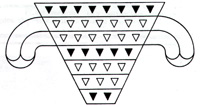
The maze of Crete (and Jordan believes the symbol belongs to a much older tradition) spread in altered forms to the Americas. "There is a definite relationship between the maze of Crete and that of the American Indian," he said. "In fact, they are almost identical. I am speaking of the square form when I say almost identical, because the round form of the Hopi is patently identical."
How the symbol reached the Americas remains an unanswered question. The similarity between the various versions is too great to be thought purely coincidental. Unlike the Cretins, however, American Indian tribes such as the Hopi, Navaho, Pima, and Papago appear to have regarded the maze as man's place of emergence from Mother Womb.
"It is well to remember that the maze is an extraordinary, yet simple, direct, straightforward symbol not only for the base year or annual circle of 360," he said, "but that it also has hidden within it, ever so ingeniously, the Venus formula. Why did the ancients hide their knowledge of the movement of the Goddess of Love through the heavens? Perhaps they did it knowing that love itself can only be discerned by the most careful search of mind and spirit."
What else lies hidden Within the ancients' symbols is for Bart Jordan to search and decipher. When he has done so, it falls to us to reacquaint ourselves with the forgotten ways of honoring the relationship we have with the cosmos.
by Steve Sherman